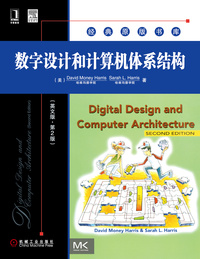数字设计和计算机体系结构(英文版·第2版)
-
作 者:
(美)David Money Harris 哈维玛德学院 Sarah L. Harris哈维玛德学院 著
- 丛 书 名: 经典原版书库
- 出版日期: 2013-12-30
- I S B N: 978-7-111-44810-5
- 定 价: ¥129.00元
内容简介
《数字设计和计算机体系结构(英文版·第2版)》基于作者丰富的教学和实践经验,以幽默的写作风格展示了最新的数字设计技术。书中采用一种独特的现代数字设计方法,先介绍数字逻辑门,接着讲述组合电路和时序电路的设计,并以这些基本的数字逻辑设计概念为基础,重点介绍如何设计实际的MIPS 处理器。另外,在全书的实例中运用SystemVerilog 和VHDL展示基于CAD的电路设计方法和技术。通过本书,读者能够构建自己的微处理器,并能够自顶向下地理解微处理器的工作原理。
《数字设计和计算机体系结构(英文版·第2版)》更新了关于微机上通用处理器以及几乎随处可见的微控制器中的I/O系统的内容,提供了多个实例来说明如何使用RS232、SPI、电机控制、中断、无线和模数转换器与外围设备交互。除了对全书内容进行更新和扩展外。新版在编程和代码例题中采用 SystemVerilog(替代Verilog)与VHDL一起给出数字系统设计的实现。第2版还提供了更多的练习题。来加强编程与处理器体系结构之间的联系。
作译者简介
David Money Harris哈维玛德学院工程学教授,拥有斯坦福大学电子工程博士学位,麻省理工学院电子工程与计算机科学硕士学位。他曾在Intel公司从事ItaniLIm和Pentium lI处理器的逻辑和电路设计,并担任Sun Microsystems、惠普、Evarls & Sutherland和其他设计公司的顾问。他的兴趣包括教学、构建芯片、户外探索。他取得了12项专利。并且与人合著了三本芯片设计方面的教材。
Sarah L.Harris哈维玛德学院工程学副教授,拥有斯坦福大学电子工程博士学位。她曾为惠普、圣地亚哥超算中心和Nvidia公司工作,擅长计算机体系结构设计和系统设计。
图书目录
Preface
About the Authors
Chapter 1 From Zero to One
1.1 The Game Plan
1.2 The Art of Managing Complexity
1.3 The Digital Abstraction
1.4 Number Systems
1.5 Logic Gates
1.6 Beneath the Digital Abstraction
1.7 CMOS Transistors
1.8 Power Consumption
1.9 Summary and a LookAhead
Exercises
Interview Questions
Chapter 2 Combinational Logic Design
2.1 Introduction
2.2 Boolean Equations
2.3 Boolean Algebra
2.4 From Logic to Gates
2.5 Multilevel Combinational Logic
2.6 Xs and Zs, Oh My
2.7 Karnaugh Maps
2.8 Combinational Building Blocks
2.9 Timing
2.10 Summary
Exercises
Interview Questions
Chapter 3 Sequential Logic Design
3.1 Introduction
3.2 Latches and Flip-Flops
3.3 Synchronous Logic Design
3.4 Finite State Machines
3.5 Timing of Sequential Logic
3.6 Parallelism
3.7 Summary
Exercises
Interview Questions
Chapter 4 Hardware Description Languages
4.1 Introduction
4.2 Combinational Logic
4.3 Structural Modeling
4.4 Sequential Logic
4.5 More Combinational Logic
4.6 Finite State Machines
4.7 Data Types
4.8 Parameterized Modules
4.9 Testbenches
4.10 Summary
Exercises
Interview Questions
Chapter 5 Digital Building Blocks
5.1 Introduction
5.2 Arithmetic Circuits
5.3 Number Systems
5.4 Sequential Building Blocks
5.5 Memory Arrays
5.6 Logic Arrays
5.7 Summary
Exercises
Interview Questions
Chapter 6 Architecture
6.1 Introduction
6.2 Assembly Language
6.3 Machine Language
6.4 Programming
6.5 Addressing Modes
6.6 Lights, Camera, Action: Compiling, Assembling, and Loading
6.7 Odds and Ends
6.8 Real-World Perspective: x86 Architecture
6.9 Summary
Exercises
Interview Questions
Chapter 7 Microarchitecture
7. l Introduction
7.2 Performance Analysis
7.3 Single-Cycle Processor
7.4 Multicycle Processor
7.5 Pipelined Processor
7.6 HDL Representation
7.7 Exceptions
7.8 Advanced Microarchitecture
7.9 Real-World Perspective: x86 Microarchitecture
7.10 Summary
Exercises
Interview Questions
Chapter 8 Memory and I/0 Systems
8.1 Introduction
8.2 Memory System Performance Analysis
8.3 Caches
8.4 Virtual Memory
8.5 I/O Introduction
8.6 Embedded I/O Systems
8.7 PC I/O Systems
8.8 Real-World Perspective: x86 Memory and I/O Systems
8.9 Summary
Epilogue
Exercises
Interview Questions
Appendix A Digital System Implementation
A.1 Introduction
A.2 74xx Logic
A.3 Programmable Logic
A.4 Application-Specific Integrated Circuits
A.5 Data Sheets
A.6 Logic Families
A.7 Packaging and Assembly
A.8 Transmission Lines
A.9 Economics
Appendix B MIPS Instructions
Appendix C C Programming
C.1 Introduction
C.2 Welcome to C
C.3 Compilation
C.4 Variables
C.5 Operators
C.6 Function Calls
C.7 Control-Flow Statements
C.8 More Data Types
C.9 Standard Libraries
C.10 Compiler and Command Line Options
C.11 Common Mistakes
Further Reading
Index


